Mark Stout of Scow Bay Boats said he is "rather thrilled" with the prospect of restoring the Western Flyer, which is not just any old wooden boat.
He started work last week overseeing what he …
This item is available in full to subscribers.
We have recently launched a new and improved website. To continue reading, you will need to either log into your subscriber account, or purchase a new subscription.
If you had an active account on our previous website, then you have an account here. Simply reset your password to regain access to your account.
If you did not have an account on our previous website, but are a current print subscriber, click here to set up your website account.
Otherwise, click here to view your options for subscribing.
* Having trouble? Call our circulation department at 360-385-2900, or email our support.
Please log in to continue |
|
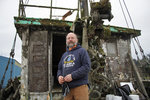
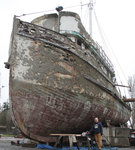
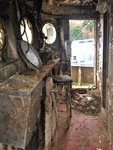
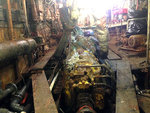
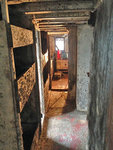
Mark Stout of Scow Bay Boats said he is "rather thrilled" with the prospect of restoring the Western Flyer, which is not just any old wooden boat.
He started work last week overseeing what he estimates would be at least a year-long restoration of the boat that famous American author John Steinbeck chartered in 1940 for an expedition to Mexico's Sea of Cortez.
"The Steinbeck thing is groovy and all that, but I'm really into it because it was built in Tacoma ... there's not many of that style left," Stout said of the 76-foot purse seiner built in 1937.
Stout seems unmoved by the boat's fame. "It's just more of what we do. Yes, it's a big project, but this is just what we do here in this boatyard."
Stout is a 1982 graduate of the Northwest School of Wooden Boatbuilding who spent 20 years in Homer, Alaska. "I fix boats for a living," he said. He moved back here about three years ago, and in September 2014, bought a large shop at the Port of Port Townsend Boatyard, formerly the home of Day Boat Works. (Stout also has a Friday-morning radio show from 8 to 10 a.m. on KPTZ FM 91.9, called the Oakum Shed.)
Stout is performing "a thorough survey" of the Western Flyer. "There are a lot of old systems" which "need to be taken apart in a careful way."
The first stage was "shoveling mud" and cleaning out the interior to make it safe for Marine Vacuum Services, a Seattle company, to pump out the bilges, which happened Feb. 26-27.
As the famous boat's many visitors can attest, "it's covered in barnacles and slime," Stout said. "A lot of those planks are going to get replaced anyway," he said. "The pilothouse will need to be scraped."
Stout said he'll be "using local workers that we're all familiar with." The vessel will be moved to a new spot in the boatyard to allow more room. Like any other boat being worked on, the Western Flyer is off limits to visitors. "It'll be a little more formal as far as not having any access," he noted.
COLORFUL HISTORY
In 1940, the seiner was chartered in Monterey, California, by American literary giant John Steinbeck and his friend Ed “Doc” Ricketts for a six-week biological collecting expedition that was the subject of Steinbeck’s 1951 book, The Log from the Sea of Cortez. The boat figured in the nonfiction book and was described as lovingly as the critters the crew collected, from crabs, urchins and sponges to tunicates and bivalves.
As Steinbeck wrote in the book, boats have a unique ability to tug human heartstrings. “The sight of a boat riding in the water clenches a fist of emotion in [a man’s] chest,” Steinbeck wrote. “A horse, a beautiful dog, arouses sometimes a quick emotion, but of inanimate things only a boat can do it.”
As a piece of tangible history and a specific individual of the purse-seining species, the Western Flyer is irresistible to Steinbeck fans, marine biologists and environmentalists, as well as those interested in wooden boat history.
INSPIRATION
John Gregg, 54, of Moss Landing, California, counts himself among the many people whose love for marine biology was influenced by Steinbeck's writings.
Gregg spent his elementary school years in Puyallup, Washington, and lived many places with his family, since his father was a government employee. Gregg is the owner of several companies including Gregg Drilling & Testing and Gregg Marine, Inc., in the Monterey area. Gregg Marine is one of the world’s leading experts in marine drilling and geotechnical investigation. His companies own work boats.
"You think I'd know enough to know better," he chuckled about why he would buy a 78-year old wooden boat that spent about four months underwater and needs total restoration.
The Western Flyer was in Skagit County when purchased in 2010, for a reported amount of about $40,000, by Gerry Kehoe of Salinas, California. The boat sank in the Swinomish Channel near Anacortes, in October 2012, was raised after two weeks, then sank and was raised again in January 2013. It was hauled out at the Port of Port Townsend on July 5, 2013, coated with barnacles inside and out.
Kehoe eventually announced a plan to salvage pieces of the boat and set them up for display in California.
The nonprofit Western Flyer Boat Project were interested in purchasing the craft for restoration, but fundraising was a challenge. Gregg was aware of the situation, and decided to get involved.
"I've been following it for a long time. After saying 'No' a half dozen times, I finally got the previous owner to say, 'Maybe'. That started a dialogue, and it led to this,” Gregg said of the purchase.
The purchase price is about $1 million. Gregg expects to spend another $2 million for restoration.
Gregg owns Gravelles' Boat Yard, advertised as "The Monterey Bay's leading resource for marine supply and haul out services." It didn't take him long to decide the restoration would be done in Port Townsend.
"Once I saw the craftsmen there, I thought, 'Geez, that's the place for it,'" he said.
Gregg saw the boat in person, for the first time, about three weeks ago. "When I saw it I was actually happy," he said. "My biggest fear was that in the 1970s someone had added formica, but it is all original inside. The skeleton of it is good and sound. It will take a lot of work, but it's all repairable."
A SCIENCE BOAT
Gregg knows he cannot satisfy Steinbeck purists who would prefer the boat to be just like it was during the Sea of Cortez adventure. The original engine is missing, and there are only two of that type of 160-horsepower motors known to operate. The plan is to install a modern diesel-electric system.
It is being restored and retrofitted to be a marine science boat with children on board, so "it has to be as safe as it can be," Gregg said. Maritime architects and the U.S. Coast Guard will be involved with the plan to add water-tight holds below deck.
Since the purchase has been made public, he's had plenty of offers from people and entities that want to participate in the restoration and operation. "I don't want to lose control of the process because I want to make sure it stays true to my vision, which is a science boat with kids on board pulling plankton nets."
Gregg knew there would be interest in his plans for the boat, yet has been pleasantly surprised at the positive reaction. "I've had many requests to re-enact the voyage" to Mexico from biologists who were inspired by the author. "It's like a Who's Who of the marine biology world."
He does not intend the boat to be used for sunset cruises or whale watches. A realistic businessman, he also does not expect the boat to turn a profit.
"I never looked at this as any kind of money-making opportunity; it'll cost and cost and cost," Gregg said.
Stout appreciates Gregg's plans for the boat. The shipwright is re-reading "Log of the Sea of Cortez" as there may be some hints he can use to rebuild parts, he said. Also, the Petrich family, which owns the Tacoma shipyard that built the vessel, still has the original plans which Stout intends to inspect.
Looking at the boat right now, Stout said, "the planking's got this nice shape to it ... you can see it's holding its shape. Planks aren't falling off, caulking isn't falling out," suggesting the fasteners are holding up. "For being out of the water almost two years, it's encouraging."
Yes, it's not just another old wooden boat. If it were, it probably would be declared a derelict vessel, and be scrapped.
"The boat arguably is worth nothing and yet it's priceless," Gregg said. "It's one of those things. It's like a piece of art. You don't really own it, you take care of it for awhile. You can't really own something like this."